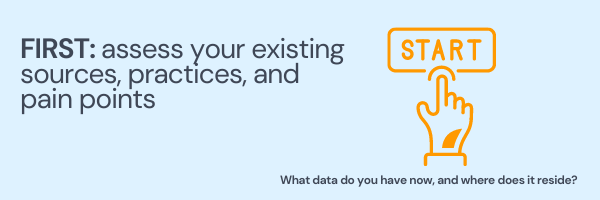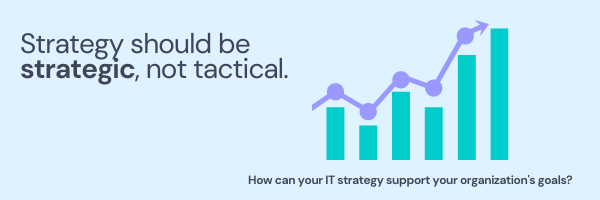

You know that your technology isn’t working properly and that real changes need to be made. But, it’s daunting to dig into all the ins and outs of your people, processes, and technology. So, where do you even begin with a full-on information technology assessment?
How can you conduct a technology capabilities assessment to sort out the right structural, process, and technical changes? You want to do a legit capabilities assessment but you don’t want to deal with all the tech jargon and IT speak, right?
Here we’ll break down the goals, elements, and process of information technology assessment, as well as key questions to ask to ensure your operations and infrastructure are empowering your organization and mission.
Table of Contents hide
An information technology assessment is a data-driven evaluation of your technology, data, and IT resources in relation to key organizational goals. It provides measurable insights and improvements to systematically align information technology to your strategic vision.
There are two main types of IT assessments: comprehensive and targeted.
A comprehensive assessment measures the health of your entire IT environment and provides an actionable IT roadmap for your people, processes, and technology to fulfill your organizational mission.
Targeted IT assessments, on the other hand, dive deep into specific activities within your IT operation.
For example, you can get a targeted assessment of your application software, data quality, analytics capabilities, cybersecurity, end-user satisfaction, and IT staffing among others. Oftentimes, you’ll hear these focused, domain-specific assessments called targeted IT Interventions.
While the naming conventions of focused and end-to-end information technology assessments may differ, the general process, analysis, and objectives should be relatively similar: ensuring your IT strategy supports the direction of your association and then wrapping your tools and applications around that strategy.
The purpose of an IT assessment is to understand how well your software, data, processes, and IT department are working for your organization. It allows you to create efficient IT systems, improve data governance, and mitigate technical debt.
Put simply: you can't improve what you don’t measure. And if you don’t know exactly what you should be measuring, and how to do so in a standardized way, then you can't improve your IT performance or its value to your organization.

It’s like running around in a maze without correctly tracking where you are or where you've been, so you’re not sure what to do to get out.
With the role that technology plays in virtually every part of business today, you’re running your organization blind if you’re not adequately assessing how well your IT is functioning and aligned with strategic organizational goals.
Information technology assessment solves this problem of “running blind.” It provides actionable solutions to your everyday challenges such as:
The elements in IT assessment depend on whether you’re conducting a targeted or comprehensive IT assessment.
There are nine primary types of targeted technology assessments that represent the nine core competencies of healthy IT.
A truly comprehensive information technology assessment, on the other hand, typically contains these four main parts: 1) IT Management, 2) IT Business Alignment, 3) User Satisfaction, and 4) IT Staffing. In practice, these can be customized based on your specific needs.
Information technology assessment helps to match your IT resources, software applications, and related functions with the expectations of key stakeholders in each department. The systematic process allows you to align IT capabilities to your organization's goals.
For example, you can see if you’re focused on all the right areas and correct your IT strategy to improve business continuity and ROI (with the least work and cost possible).
Let’s break down the benefits of conducting a data-driven information technology assessment in three key dimensions: your people, processes, and technology.
Is your association struggling with the question of IT staffing?

Scale the effectiveness of your core IT processes.
Make informed decisions about your applications.
In short, IT capability assessment essentially measures your technical resources, skill sets, risks, and priorities to highlight areas of friction and opportunities to better fulfill the goals and strategy of your organization.

The IT assessment process generally includes 1) quantitative survey of end users and/or targeted stakeholders, 2) standardized qualitative interviews, 3) customized IT improvement roadmap, and 4) detailed report and/or presentation of findings.
Comprehensive information technology assessment use quantitative instruments along with qualitative stakeholder interviews to gather key individual feedback and consensus-based results. Those interview results drive deep-dive analysis to separate root cause from symptoms.
The findings are then collated into an actionable plan or “IT roadmap” for optimizing technology, process, and people. The reports and recommendations should use clear, non-IT speak to ensure IT and executives are all on the same page and can adjust accordingly to improve and align IT.
The timeframe of a comprehensive information technology assessment, from start to finish, takes about 6-10 weeks depending on the size of your organization and the availability of your staff.
Targeted evaluations of a particular tech function deploy domain-specific surveys with targeted stakeholders, end users, IT staff, and/or non-IT company executives.
The exact IT function or service area that’s being measured impacts who is surveyed and interviewed because each IT competency area has its unique problems, risks, root causes, and solutions.
Recommendations for optimizing the technology processes, people, and technology within the focus area are then produced and presented. The timeframe is about 4-6 weeks for targeted IT assessments.
Here's how you can conduct an IT assessment at your organization.

The first thing you should do is make a list of the main business questions, challenges, or needs that need to be tackled during the assessment.
Let’s say that, for one reason or another, your data just isn’t working for your organization.
You might have the following questions about how data works for you (or not):
In this example, you might need to conduct a targeted data quality assessment, or perhaps an assessment of your analytics capabilities.
Defining these types of basic questions will support the decision about which type of assessment you need.
The second step is to get answers directly from the source. Survey relevant stakeholders from each department who actually use and/or rely on your technology and data every day. This may include power users, management, and/or executives depending on the type of IT assessment.
For example, the survey respondents of an IT Management Assessment should include anyone in management/leadership in the IT department, as well as power users who work with your software systems and run data tasks regularly.
An IT Business Alignment Assessment, on the other hand, surveys key stakeholders and executives outside of IT (aka CEOs, CFOs, CXO, board members, key management folks, etc.).
And a User Satisfaction Assessment surveys all technology and data end users. This includes everyone from front-line individual contributors all the way to executives, except for IT staff. It’s the IT Staffing Assessment that surveys all IT staff, including the CIO.
The goal here is to systematically analyze your workflow, technology, data, processes, and staff skills in relation to those core questions and challenges outlined in step #1. The survey itself should be standardized and quantitative.
The third step in a comprehensive IT assessment is to interview relevant stakeholders and/or end users in each department. The exact interviewees depend on the type of assessment.
The interview itself should be structured with targeted questions that provide qualitative/descriptive feedback that can shine more light on the survey findings. In other words, to answer “the why.”
The questions asked during the interview should be standardized. And remember, you don’t just want to find out what’s happening today. You also want to find out what you need for the next phase of your development and digital transformation.
The fourth step is to systematically organize and interpret the surveys and interviews to clearly define recurring issues and opportunities.
This is when you’ll score the data gathered in the assessment and break down the scores and feedback by department and across key service areas.
These results and analysis should be rich in detail and information. You should also embed suggestions on what an assessment score means and how to use that information for improvement.
The fifth step is to build a strategic IT improvement roadmap to address the problem areas that are now clearly defined.

Remember that these action items should be aligned with and prioritized based on your mission, business plan, and growth projections.
The goal here is to map out a short-term and long-term plan to better use technology in order to move your organization forward. This improvement program will also allow you to effectively implement training for individuals or departments who’ve requested it.
So, consider what your ideal workflow would look like and how your current processes, technology, and organizational design should change to support your growth plans.
If you’re looking to measure and optimize your technologies, digital capabilities, and costs, then you’ll want a truly comprehensive information technology assessment.
Look for an end-to-end diagnostic that includes two essential components.
Now, if you’re looking for a targeted evaluation of your core IT functions, then you’ll want to select from the following:
| IT Management | Software |
| User Satisfaction | Data Quality |
| IT Business Alignment | Analytics Capability |
| IT Staffing | Security |
| Executive Alignment |
Be sure that the diagnostic you go with, more or less, maintains that three-dimensional “people, process, and technology” framework in relation to your priorities and mission.
Ideally, the focus should be on your people, strategy, and process first and then your technology and applications should follow, not the other way around.
In other words, look for a service that starts with your process and then adapts the technology accordingly.
Each type of information technology assessment has a unique set of questions. You can add or customize IT assessment questions but you can’t change their core meaning. The survey and interview questionnaire should be based on industry-standard research.

For example, if you’re doing a data quality discovery, then some questions you’d want to ask include:
You can do a self-assessment if you use a reliable, industry-standardized set of questions, and your expectations aren’t too lofty. However, it’s best practice to hire a third-party IT expert in your industry niche to conduct the information technology assessment.
An impartial specialist should be able to ask the right questions and approach the assessment without any preconceptions or biases about your current applications, strategy, team members, and workflows.
Beyond preserving the integrity of the assessment and keeping the results untainted, a reputable third party may also be more approachable to your staff than management or business leadership when it comes to opening up about your organization’s technical capabilities.
Your IT team is more likely to relay valuable feedback when potential backlash, repercussions, and existing relational dynamics are removed from the equation. In other words, they may feel more comfortable airing the dirty laundry to an unbiased outsider.
Are you interested in an information technology assessment? We specialize in administering, dissecting, and collating technical assessments into actionable improvement programs for associations and membership-based organizations.